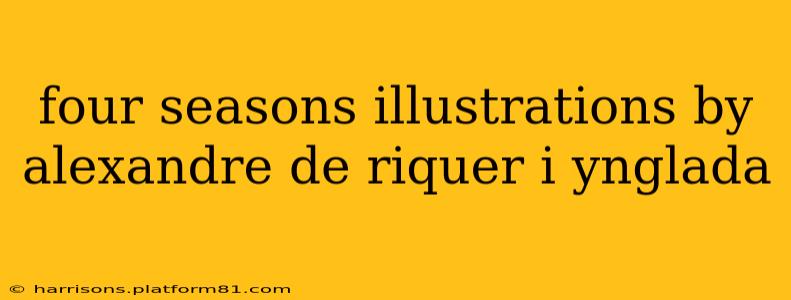Alexandre de Riquer i Ynglada, a prominent figure in Catalan Art Nouveau, left an indelible mark on the artistic landscape with his evocative and meticulously detailed illustrations. His depictions of the four seasons are particularly noteworthy, showcasing his mastery of line, color, and symbolic representation. This exploration delves into the artistry behind Riquer's seasonal illustrations, examining their unique characteristics and lasting impact.
What is the style of Alexandre de Riquer i Ynglada's illustrations?
Riquer's style is firmly rooted in Art Nouveau, yet possesses a distinct Catalan flair. He masterfully blended the sinuous lines and organic forms characteristic of the movement with elements of local flora and fauna, creating a uniquely recognizable aesthetic. His use of rich, jewel-toned colors further enhances the luxurious and dreamlike quality of his work. His illustrations frequently feature stylized figures, often female, interacting harmoniously with nature, reflecting a deep connection between humanity and the natural world.
What are the key elements of Riquer's four seasons illustrations?
Riquer's depictions of the four seasons are not simply literal representations; they are allegorical expressions of the cycle of life and the changing moods of nature. Each season is imbued with its own distinct personality and symbolic meaning:
- Spring: Expect vibrant colors, blossoming flowers, and youthful figures celebrating the renewal of life. The imagery often evokes a sense of optimism and burgeoning energy.
- Summer: Summer illustrations typically portray scenes of abundance and leisure. Think lush landscapes, ripe fruits, and figures enjoying the warmth of the sun. The overall mood is one of contentment and fulfillment.
- Autumn: Riquer's autumnal scenes often feature a shift in tone, reflecting the transition from summer's vibrancy to the approaching winter. Expect warmer, earthier colors, and images that evoke a sense of harvest and reflection.
- Winter: Winter illustrations tend towards a more subdued palette, with muted colors and scenes of stillness. The imagery might suggest a sense of introspection or the quiet beauty of a dormant landscape. However, even in winter, Riquer often hints at the promise of spring's return.
Where can I see examples of Riquer's four seasons illustrations?
Unfortunately, there isn't a single, easily accessible online collection specifically dedicated to Riquer's four seasons illustrations. His works are often dispersed across various archives, museums, and private collections. To find examples, you'd need to research specific museums and institutions holding his artwork, such as those specializing in Catalan Art Nouveau. Searching online image databases using specific keywords like "Alexandre de Riquer quatre estacions" (Catalan for "four seasons") or "Alexandre de Riquer illustrations seasons" might yield some results.
How did Riquer's background influence his art?
Riquer's Catalan heritage is deeply woven into his artistic expression. His deep understanding and appreciation of Catalan landscapes and culture are evident in his choice of subjects, the stylistic elements he employed, and the overall atmosphere he created in his works. This grounding in his cultural context is what gives his art its unique character and distinguishes it within the broader Art Nouveau movement.
What is the significance of Riquer's illustrations today?
Riquer's illustrations remain relevant today as testaments to the enduring appeal of Art Nouveau and the power of symbolic representation. His meticulous attention to detail, his evocative use of color, and his ability to capture the essence of the natural world continue to inspire and captivate audiences. His work serves as a valuable window into the artistic and cultural landscape of late 19th and early 20th-century Catalonia.
What techniques did Riquer use in his illustrations?
Riquer was a master of various illustration techniques, often combining different methods to achieve his desired effects. While precise details on his techniques for each specific work are scarce, he likely employed a combination of pen and ink drawings, watercolor washes, and possibly gouache for color and shading. His skill in line work is especially apparent, contributing to the delicate yet powerful aesthetic of his illustrations. Further research into specific pieces might reveal more about the individual techniques used.
This exploration provides a comprehensive overview of Alexandre de Riquer i Ynglada's captivating four seasons illustrations. While the specific works remain scattered, their lasting impact on the world of Art Nouveau and illustration is undeniable. His unique blend of Catalan identity and Art Nouveau aesthetics continues to resonate with art enthusiasts and scholars alike.
